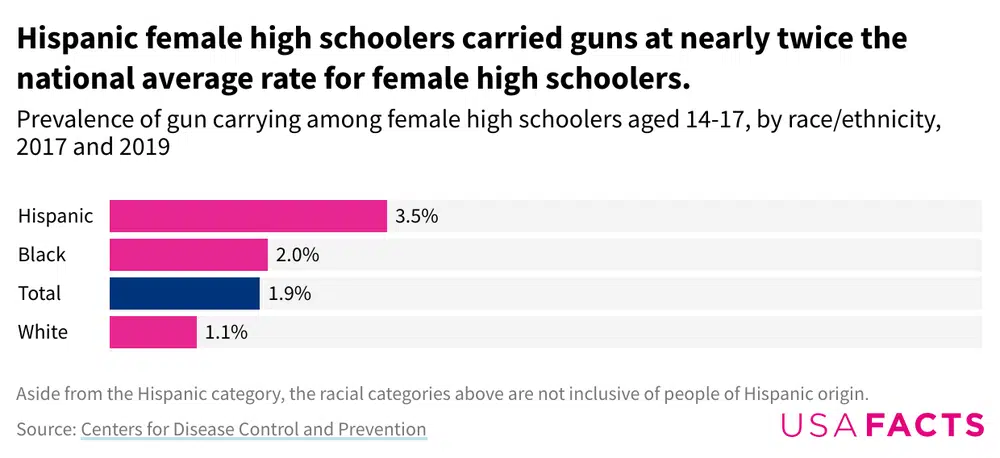Guns play a significant role in youth violence. They are used in 46% of adolescent suicides and 93% of adolescent homicides — the second and third highest causes of death for kids ages 14 to 17.
Centers for Disease Control and Prevention (CDC) data from 2017 and 2019 says that 6.8% of males and 1.9% of females of these ages carried a gun at least once in the previous 12 months.
Among male high schoolers, gun carrying was most prevalent among Black youth: at 10.6%, followed by Hispanic youth at 7.2%.[1]
Among female high schoolers, gun carrying was most prevalent among Hispanic youth: at 3.5%, followed by Black youth at 2%.

In its review of the racial and ethnic differences in rates of gun carrying, the CDC points to concentrated poverty, high crime rates, and residential instability as factors that worsen violence in underserved communities. The CDC also notes that young people with experiences of violence and racism may be less likely to be able to rely on police and more likely to feel as if they must carry a gun for self-protection.
The study also found significant associations between youth gun carrying and a history of experiencing violence, suicidal attempts, and substance use.
What are the experiences of gun-carrying male high schoolers?
Some gun-carrying male high schoolers had experienced violence at school. Twenty-six percent of students who were threatened or injured with a weapon on school property carried a gun. Furthermore, 21% of students who had gotten into a physical fight on school property, and 21% of students who missed school because it felt unsafe,[2] carried a gun.
Sexual violence also emerged as a major risk factor for male high schoolers: 24% of those who experienced sexual violence, and 33% of those who experienced sexual dating violence, carried a gun.
Finally, substance use was also a significant factor: 23% of those who had misused prescription drugs at least once, 20% of those who had used illicit drugs at least once, and 19% of those who recently engaged in binge drinking carried a gun.
What are the experiences of gun-carrying female high schoolers?
Feeling unsafe at school also was a significant risk factor for gun-carrying female high schoolers: 12% of students who had gotten into a physical fight on school property and 11% of students who had been threatened or injured with a weapon on school property carried a gun.
Dating and sexual violence was also a risk factor, though to a lesser extent than what it was for male students: 8% of female students who experienced physical dating violence, and 6% of female students who experienced sexual violence, from their romantic partner or otherwise, carried a gun.
Understanding risk factors of youth gun carrying are critical to violence prevention. The CDC recommends addressing factors such as youth substance use and gun carrying to help the youths who remain the most vulnerable to experiencing violence.
For a fuller picture of health in the US, read about the biggest mental health issues facing young Americans and how crisis teams handle mental health calls differently from police. Get the data directly in your inbox by signing up for our weekly newsletter.
[1] The data was aggregated across 2017 and 2019.
[2] At least once in the month prior to the survey







